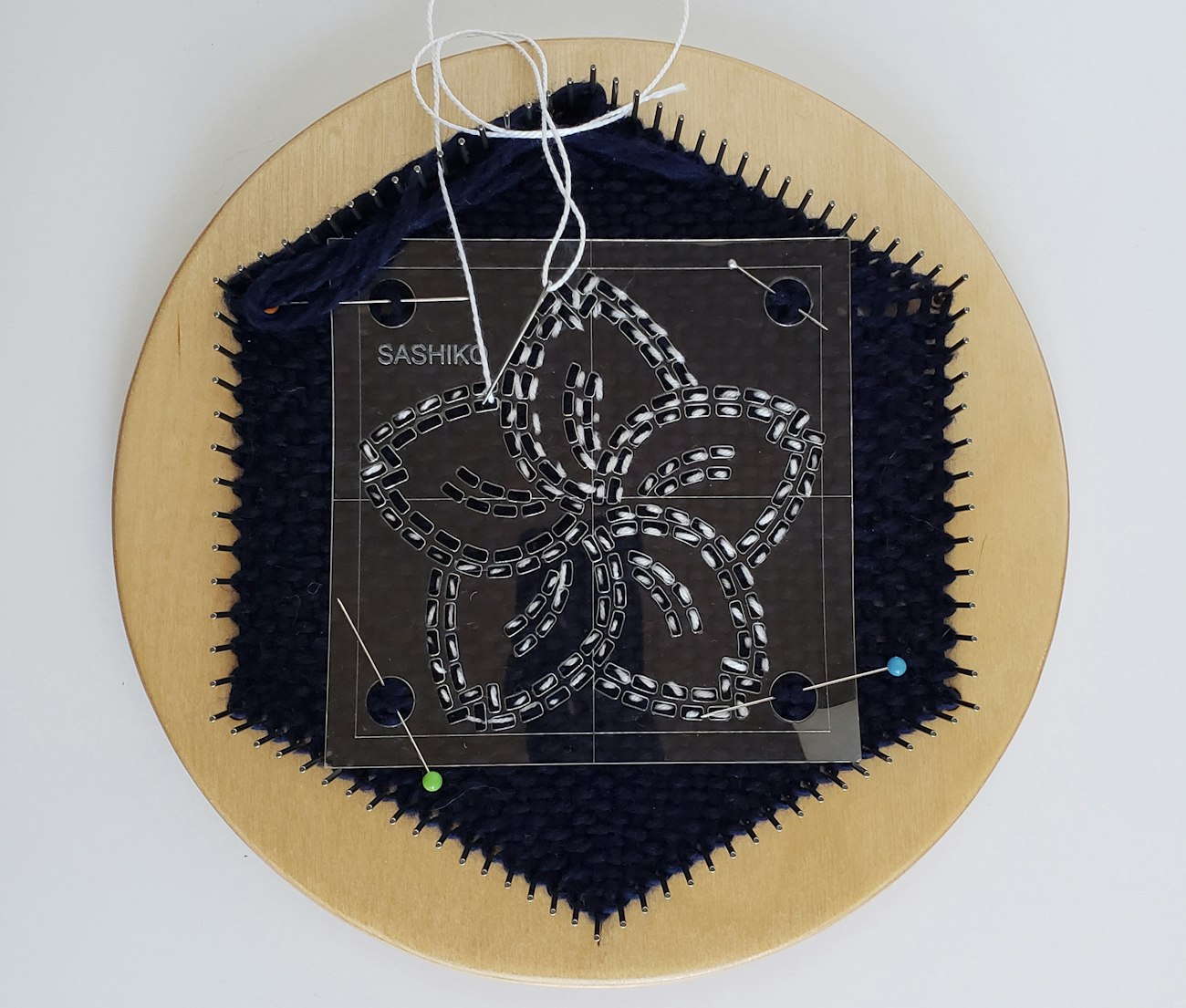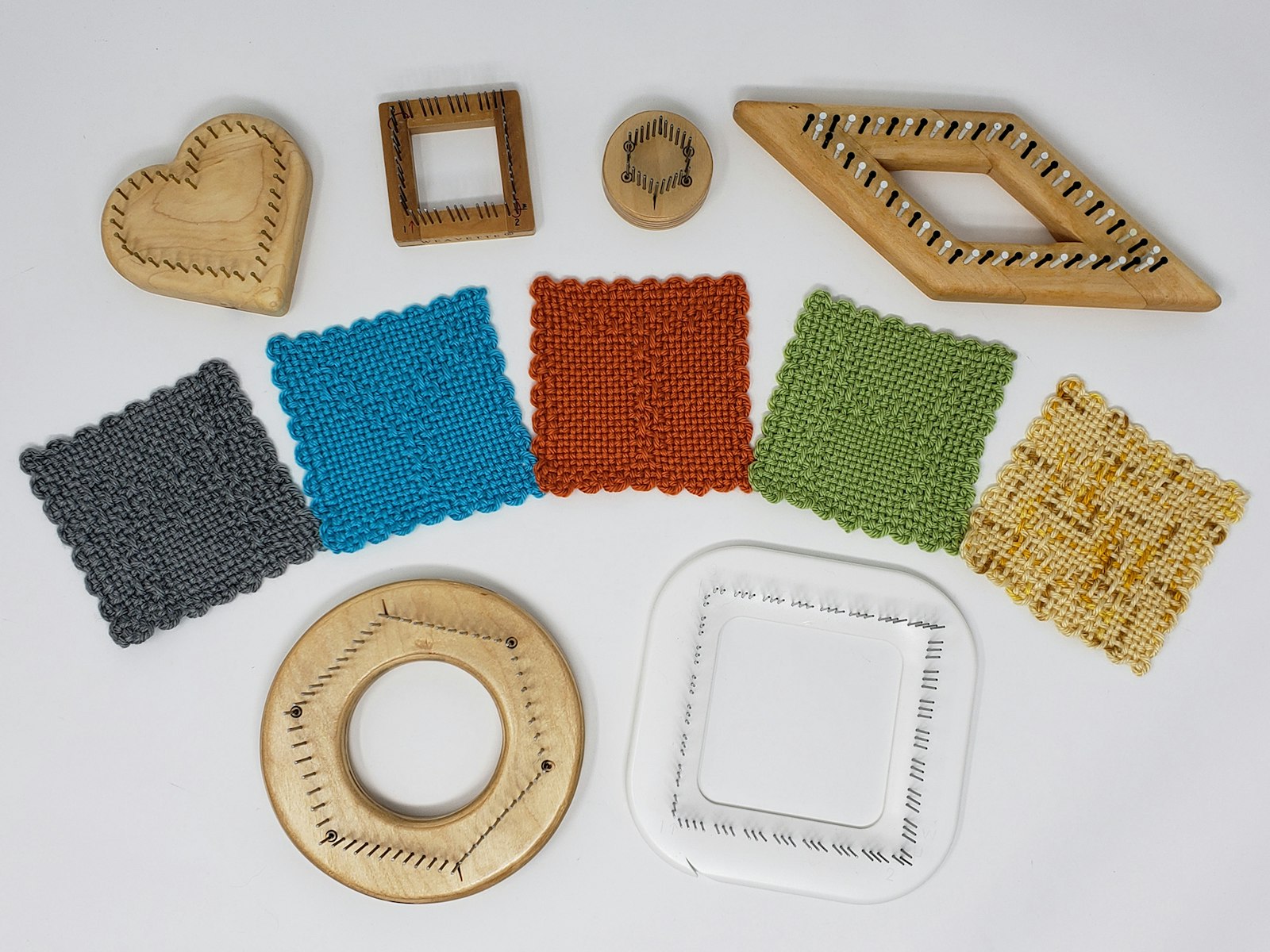In the many articles about choosing a loom, pin looms are rarely included, and in most cases their existence isn’t even mentioned. But pin looms are looms with their own unique characteristics, and you should know about them. This article is not about which pin loom to choose, but why you might want to add a pin loom to your weaving toolbox. I’ll start by busting some of the myths about pin looms and then tell you about some of the benefits of pin-loom weaving.
Pin-Loom Myths
Pin looms are toys.
The Oxford English Dictionary defines the word toy as “an object for a child to play with, typically a model or miniature replica of something.” While older children often enjoy pin-loom weaving, the majority of pin-loom weavers are adults. In addition, pin looms are not replicas, but follow their own designs: They are usually a frame with pins that is used with a specific weaving method to create a shaped piece of fabric. (That said, I have a friend who lovingly refers to her AVL Studio Dobby Loom as her “favorite toy,” which throws the whole “it’s not a toy” thing into doubt!)Pin looms are potholder looms.
This is just not true. While many of us learned the “over and under” of basic weaving using fabric loops on a square metal potholder loom, pin looms typically use yarn and not loops. Pin-loom weaving methods can involve anything from a classical warp/weave approach to continuous strand weaving or—as in the case of the most popular Weave-It-style looms—the use of the formerly patented, wind/weave method. Those methods have been tried on potholder looms … but that doesn’t make a potholder loom a pin loom!Pin looms are for people who can’t afford a real loom.
Mankind has been weaving clothing and other useful fiber things for a few thousand years on all kinds of equipment, expensive or not. I don’t believe you could craft a plausible argument that it depends on the amount of money that you spend on whether you can weave something amazing. For instance, how about fiber enthusiasts who weave on some branches from the backyard? Does that mean they don’t have money to afford a loom? Not at all! They weave on branches because they enjoy doing so, and some of them create very impressive pieces. You weave on a pin loom because you appreciate the things that you create with it, no matter how little or how much it costs.ADVERTISEMENTYou can make only little squares.
Pin-loom tradition as we understand it started in the early 1930s with the 4" square Weave-It Loom. This type of loom has been widely popular ever since, and it is now available in many sizes from an inch to more than a foot. Over time, new shapes were added—rectangles, triangles, diamonds, hexagons, and even hearts and dragonflies. More shapes are likely to come while creative minds find new ways to weave different shapes!You can weave only plain weave.
Even early vintage pattern booklets took pride in providing a large library of pattern weaves that today are readily available to pin-loom weavers online, free of charge. Many are pick-up patterns, but there are also a myriad of options to work with colors, and the two concepts can be combined. In additon, pin looms provide a great opportunity for trying out elaborate patterns—such as Bronson lace, Danish medallions, overshot, even hand-manipulated techniques such as sumac—at little risk. If you try a new technique and aren’t happy with the results, your investment in time and resources is very small.

The Mystic Blue Whale Pillow by Margaret Stump from Little Looms Summer 2022 proves that you can do some very creative and fun things using pin-loom squares! Photo by Matt Graves
- You cannot do much with a pin loom.
Some pin-loom weavers create piles of little squares, and that suits them in terms of the relaxation and stress relief they get from working with pretty fibers on a small loom. Others venture into making projects, and imagination is their only limit. You can start with that one weavie coaster, or a 4-squares table topper, but there’s nothing that prevents you from using more weavies to make a cowl, or a scarf, a towel, a shawl, stuffed animals, a poncho, a coat, … or a one-a-day 365 weavies temperature blanket … or even a king-size bedcover.Pin-Loom Benefits

Use a pin loom to sample with hand-dyed or hand-spun yarns. You won’t sacrifice a lot in terms of time or materials, but you will gain a wealth of knowledge. Photo by Gabi van Tassell
Quick sampling
Pin looms are uniquely suited to provide a quick-and-simple sampling platform. In an article by Madeline Keller-King from Spin-Off Fall 2021, “Spinning in Color for Pin-Loom Weaving,” Madeline highlights pin-loom weaving as a quick, gratifying method of testing spinning samples. As she says, “Each square is a miniature documentation of choices that I get to make as a spinner—fiber type, fiber management, drafting technique, and so on.” Several of my indie dying friends appreciate a quick hexagon sample because it gives them a first impression of how a dyed fiber might look as fabric, or how several color runs will look when put together.Perfect portability
If you think your rigid-heddle loom is portable, consider this: A pin loom fits in a pocket or small purse. You can conveniently work on it in a car (as a passenger!), and you can weave while sitting or standing. Set-up time is minimal. You can pause at any point without notice, a handy feature when you’re finally called for your appointment or the kids storm off the school bus.

Before taking a pin-loom piece off the loom, you can work directly on the tensioned fabric. Photo by Gabi van Tassell
Tensioned canvas
A pin-loom woven piece of fabric still on the loom provides an instant, perfectly tensioned canvas for embroidery, needle felting, or rug hooking.Self-contained fabric
Quilting relies on small pieces of fabric. Imagine weaving those pieces, with instant smooth edges, instead of cutting them.Creative flexibility
Consider using pin-loom weaving with rigid-heddle or multi-shaft weaving and combine the best of two worlds. For example, in garment construction you can weave large areas in panels on a larger loom, then use pin-loom weaving to shape the garment.

Photo by Anthony Thompson
Fellow pin-loom weaver Anthony Thompson recently shared the photo above, which shows pin-loom weaving at its best. He beautifully combined creative thinking, lovely yarns, different looms, and playing with patterns and colors, using a calming activity to create an enjoyable and practical home accessory.
Look for more inspiration in Easy Weaving with Little Looms. But be aware and browse at your own risk: Pin looms are addictive, and soon you might find yourself wondering which pin loom to get first, or even next.

